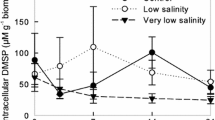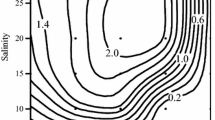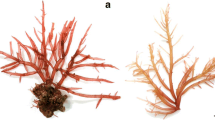Abstract
The agarophyte Gracilaria cornea, collected over 2.5 y in the Florida Keys, shows adaptations to oceanic salinities and subtropical to tropical water temperatures in its photosynthetic and respiratory responses as measured with a respirometer. No seasonal pattern in responses to irradiance, temperature, and salinity were evident between five collections over a 20-month period, indicating the tropical nature of the populations from Bahia Honda and Pigeon Keys. Concentrations of chlorophyll a (0.09 to 0.41 mg g d wt-1) and phycoerythrin (0.06 to 0.36 mg g d wt- 1) were low and reflect the low nutrient regime of the habitats, especially when compared to laboratory cultured plants. Compensation and saturation irradiances were also low (11–38 and 90–127 μmol photon m-2 s-1), indicating acclimation to lower irradiances in their shallow (1–2 m depth) habitats where turbidity can be high. In comparison with other subtropical and warm temperate species of Gracilaria, G. cornea had lower levels of pigment, but similarly high photosynthetic efficiency, demonstrating shade adaptation; it had only limited tolerance to salinities below 20‰ and temperatures below 15 °C. Thus, G. cornea from the Florida Keys in mariculture would require subtropical to tropical temperatures and stable oceanic salinities.
Similar content being viewed by others
References
Abbott IA (1995) A decade of species of Gracilaria (sensu latu).In: Abbott IA (ed.), Taxonomy of Economic Seaweeds. Vol. V. California Seagrant Publication, California Seagrant College, University of California, La Jolla CA: 185-196.
Areces AJ, Araujo M (1996) Influencia de la salinidad y la temperature sobre el crecimiento de Bryothamnion triquetrum(Rhodophyta: Rhodomelaceae). Revue Biologia Tropica 44: 449-454.
Baghadahli D, Tremblin G, Pellegrini M, Coudret A (1990) Effects of environmental parameters on net photosynthesis of a free-living brown seaweed, Cystoseira barbataforma repens:Determination of optimal photosynthetic culture conditions. J. appl. Phycol. 2: 281-287.
Bird CJ (1995) A review of recent taxonomic concepts and developments in the Gracilariaceae (Rhodophyta). J. appl. Phycol. 7: 255-267.
Croley FC, Dawes CJ (1970) Ecology of the algae of a Florida Key. A preliminary checklist, zonation, and seasonality. Bull. mar. Sci. 20: 165-185.
Dawes CJ (1974) Marine Algae of the West Coast of Florida. University of Miami Press, Coral Gables, FL.
Dawes CJ (1979) Physiological and biochemical comparisons of Eucheumaspp. (Florideophyceae) yielding iota-carrageenan. Proc. Int. Seaweed Symp. 9: 199-208.
Dawes CJ (1985) Respirometry and manometry. pp. 329-348. In: Litter MM, Littler DS (eds) Handbook of Phycological Methods. Ecological Methods: Macroalgae. Cambridge University Press, Cambridge.
Dawes CJ (1994) Physiological differentiation of the red seaweed Gracilaria tikvahiaefrom a mangal estuary, exposed coast, and culture. Bull. mar. Sci. 54: 361-366.
Dawes CJ (1998) Marine Botany. 2nd edition. J.Wiley & Sons, New York, 480 pp.
Dawes CJ, Koch EW (1988) Physiological acclimation of the Caribbean seaweeds Eucheuma isiformeand Solieria filiformis(Rhodophyta, Gigartinales) in culture. Caribbean J. Sci. 24: 89-94.
Dawes CJ, Koch EW (1991) Branch, micropropagule and tissue culture of the red algae Eucheuma denticulatumand Kappaphycus alvareziifarmed in the Philippines. J. appl. Phycol. 3: 247-258.
Dawes CJ, Kovach CW (1992) Ecology of the algae of a Florida Key II. Effects of irradiance, salinity and desiccation on intertidal and subtidal populations of seven macroalgae. Bull. mar. Sci. 50: 165-170.
Dawes CJ, Moon RE, Davis MA (1978) Photosynthetic and respiratory rates and tolerances of benthic algae from a mangrove and salt marsh estuary: A comparative study. Estuar. Coast. mar. Sci. 6: 175-185.
Dawes CJ, Moon RE, LaClaire J (1976) Photosynthetic responses of the red alga, Hypnea musciformis(Wulfen) Lamouroux (Gigartinales). Bull. mar. Sci. 26: 467-473.
Durako MJ, Dawes CJ (1980) A comparative seasonal study of two populations of Hypnea musciformisfrom the east and west coasts of Florida, USA. II. Photosynthesic and respiratory rates. Mar. Biol. 59: 157-162.
FAO (1993) Aquaculture Production 1985-1991. FAO Fisheries Circular 815, Review 5. FAO, Rome, Italy.
Feile-Pelegrin Y, Robledo D (1997) Effects of season on the agar content and chemical characteristics of Gracilaria corneafrom Yucatan, Mexico. Bot. mar. 40: 285-290.
Friedlander M, Dawes CJ (1984) Studies on spore release and sporeling growth from carpospores of Gracilaria foliifera(Forsskal) Borgesen var. angustissima(Harvey) Taylor. II Photosynthetic and respiratory responses. Aquat. Bot. 19: 233-241.
Friedlander M, Levy I (1995) Cultivation of Gracilariain outdoor tanks and ponds. J. appl. Phycol. 7: 315-324.
Haglund K, Pedersen M (1993) Outdoor pond cultivation of the subtropical marine red alga Gracilaria tenuistipitatain brackish water in Sweden. Growth, nutrient uptake, co-cultivation with rainbow trout and epiphyte control. J. appl. Phycol. 5: 271-284.
Hurtado-Ponce AQ, Samonte GPB, Luhan MR, Gauanzon N, Jr (1992) Gracilaria(Rhodophyta) farming in Panay, Western Visayas, Philippines. Aquaculture 105: 233-240.
Jensen A (1993) Present and future needs of algae and algal products. Hydrobiologia 260/262: 15-23.
Lapointe BE, Duke CS (1984) Biochemical strategies for growth on Gracilaria tikvahiae.(Rhodophyta) in relation to light intensity and nitrogen availability. J. Phycol. 20: 488-495.
Lapointe BE, Tenore KR, Dawes CJ (1984) Interactions between light and temperature on the physiological ecology of Gracilaria tikvahiae(Gigartinales: Rhodophyta). Mar. Biol. 80: 161-170.
Littler MM, Littler DS, Lapointe BE (1988) A comparison of nutrient-and light-limited photosynthesis in pasmmophytic versus epilithic forms of Halimeda(Caulerpales, Halimedaceae) from the Bahamas. Coral Reefs 6: 219-225.
Mathieson AC, Dawes CJ (1986) Photosynthetic responses of Florida seaweeds to light and temperature: A physiological survey. Bull. mar. Sci. 38: 512-524.
McHugh DJ (1991) Worldwide distribution of commercial resources of seaweeds including Gelidium. Hydrobiologia 221: 19-29.
Norris JN (1985) Gracilariaand Polycavernosafrom the Caribbean and Florida: Key and list of the species of economic potential. pp. 101-114. In: Abbott IA, Norris JN (eds), Taxonomy of Economic Seaweeds. California Seagrant Publication, California Seagrant College, University of California, La Jolla.
O'Neal SW, Prince JS (1988) Seasonal effects of light, temperature, and nutrient concentration and salinity on the physiology and growth of Caulerpa paspaloids(Chlorophyceae). Mar. Biol. 97: 17-24.
Penniman CA, Mathieson AC (1985) Photosynthesis of Gracilaria tikvahiaeMcLachlan(Gigartinales, Rhodophyta) from the Great Bay Estuary, New Hampshire. Bot. mar. 28: 427-435.
Robledo RD (1994) Conocimiento de la macroflora marina de interes economico en las costas de Yucatan. Comision Nacional para el uso y conocimiento de la Biodiversidad CONABIO (FB 118-B077-94).
Smith AH (1997) Seamoss Cultivation in theWest Indies. Caribbean Natural Resources Institute (CANARI), St. Lucia, West Indies.
Subbaraju DP, Ramakrishna T, Murthy MS (1982) Influence of changes in salinity, pH, and temperature on the spores and sporelings of Padina tetrastromaticaHauck. J. exp. mar. Biol. Ecol. 58: 163-173.
Titlyanov EA, Titlyanova TV, Skriptsova AV (1995) Experimental field cultivation of the unattached form of Gracilaria verrucosain Russia. Russian J. mar. biol 21: 124-134.
Westermeier R, Gomez I, Rivera P (1993) Suspended farming of Gracilaria chilensis(Rhodophyta, Gigartinales) at Cariquilda River, Maullin, Chile. Aquaculture 113: 215-229.
Yakovleva IM, Papashvili EV, Titlyanov EA (1997) Photosynthesis and respiration of unattached form of the red alga Gracilaria verrucosagrowing under different conditions of illumination and water mobility. Russian J. mar. Biol. 23: 37-43.
Author information
Authors and Affiliations
Rights and permissions
About this article
Cite this article
Dawes, C., Orduña-rojas, J. & Robledo, D. Response of the tropical red seaweed Gracilaria cornea to temperature, salinity and irradiance. Journal of Applied Phycology 10, 419–425 (1998). https://doi.org/10.1023/A:1008021613399
Issue Date:
DOI: https://doi.org/10.1023/A:1008021613399




